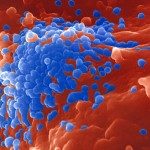Lien vers Pubmed [PMID] – 23121095
BJOG 2013 Jan;120(1):41-9
OBJECTIVE: The objectives of the study were to investigate high-risk human papillomavirus (HR-HPV) infection and type distribution in women infected with HIV-1, and to determine the relevance of HR-HPV positivity and persistence/loss to the development of high-grade cervical disease.
DESIGN: A total of 518 European women infected with HIV attending for routine gynaecological care consented to 6-monthly follow-up visits over 3 years, with surveillance of cytology, colposcopy and histopathology, where relevant, and longer follow-up, where possible.
SETTING: European women infected with HIV attending for routine gynaecological care.
POPULATION OR SAMPLE: 518 European women infected with HIV attending for gynaecological care in 6 hospital-based European centres – Dublin, Edinburgh, London, Milan, Paris, and Warsaw.
METHODS: Cervical screening was achieved by liquid-based cytology (LBC) of brush samples in PreservCyt® medium. The HPV testing of residual samples was performed by Hybrid-Capture II, with genotyping of positives using the HPV Line Blot Assay. Histology results were accessed where available.
MAIN OUTCOME MEASURES: Description of high risk human papillomavirus (HR-HPV) infection and type distribution in HIV-1 infected women.
RESULTS: The estimated prevalence at baseline of any HR-HPV type was 49.5% (46.3-52.8%): 10.2% for HPV 16 and 4.3% for HPV 18. The prevalence increased with increasing immunosuppression. Multiple infections were detected in 26.8%. HR-HPV genotypes were detected in 34.9% of cases with normal cytology, in 77.2% of cases with atypical squamous cells of undetermined significance/low-grade squamous intraepithelial lesion (ASCUS/LSIL) and in 90.8% of cases with high-grade SIL (HSIL). The prevalence of HPV 16 in HSIL was 38.5%, with the three most common types thereafter having prevalence rates of 19.2% (HPV 58), 19.2% (HPV 53) and 16.6% (HPV 52). The overall persistence of any high-risk type was 55.8%. We found that 6 months persistence of HPV 16 occurred in 24 women. Seven cases of high-grade cervical disease developed, and all were associated with initial/persistent HR-HPV positivity.
CONCLUSIONS: A wide diversity of HPV types was evident, and multiple infections were common. Detection or persistence of any HR-HPV was associated with a very low incidence of subsequent high-grade disease.

